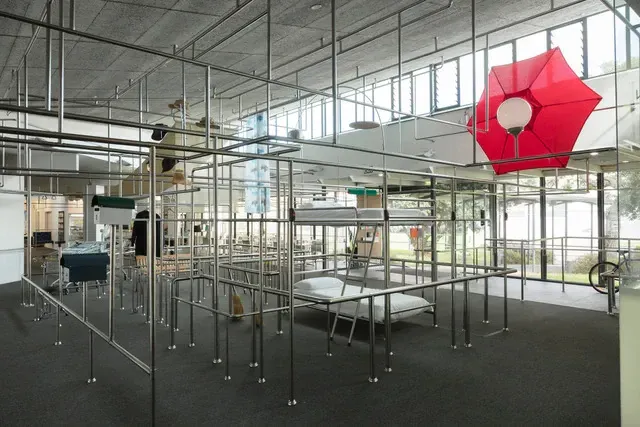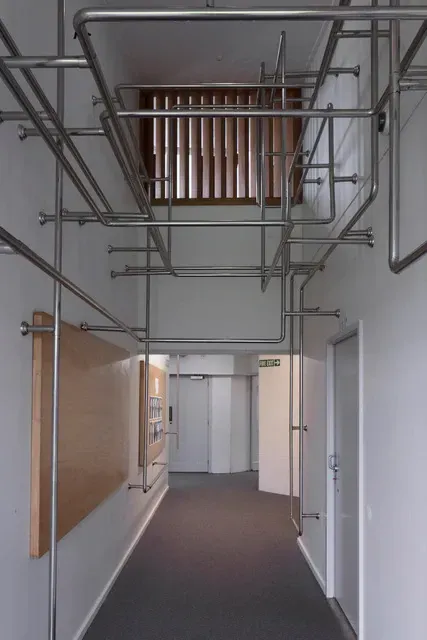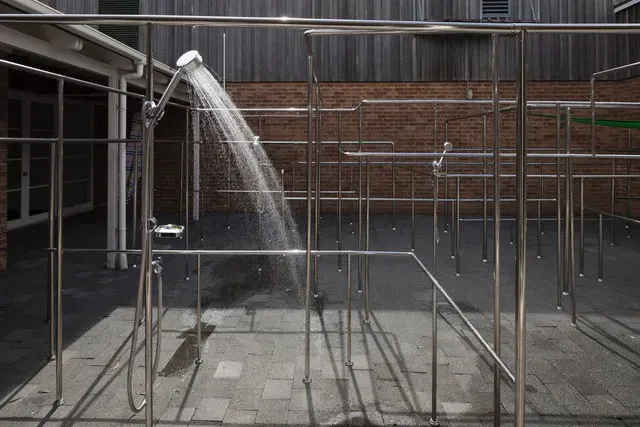Spatial Discomfort
Written by

Increasingly in galleries there’s a tension crackling in the air between what an art project is trying to explore and the white cube it is in. The number of exhibitions that ask us to engage in reading, conversation, screenings, or try to create a closer relationship with objects can leave spaces designed for don’t-touch big paintings and sculptures feeling awkward. We’re left mid-space fidgeting, feeling uncomfortable.
There are exhibitions consciously exploring this tension in the gallery beautifully. Bad Visual Systems by Ruth Buchanan at Adam Art Gallery late last year, or the recent installation works of Peter Robinson and Sonya Lacey come to mind. These artists work smartly to the gallery space.
But I tire of countless exhibitions where the goals of the project are not well met by the design of the spaces they’re in. The distraction they undertake to meet the clean cut lines, rather than to find their own shape. With so much work talking of relationships between ourselves and the work, and each other, we want places to meet, sit, talk and touch. For public galleries looking at refits, there is huge scope to reconsider the sorts of spaces to enable artists and communities to meet.
Yona Lee’s In Transit (Arrival) provides on this plenty to think on. Likely one of the most ambitious installations in New Zealand of the year, kudos to Te Tuhi in Pakuranga, Auckland for its significant investment in the infrastucture to pull it off, and in this talented young artist (a masters Elam graduate of 2010).
In Transit avoids Te Tuhi’s gallery spaces entirely. It is everywhere but: a bold entangling of Te Tuhi in a stainless steel tube matrix, moving through the building’s courtyard, corridors, central foyer and café, a kitchen, and even into the toilets. Lamps, mops, letterboxes, showerheads, consumer goods and curtains popping up and out of the steelframe, flying at absurd surreal angles. Like a capitalist industrial creeper virus colonising the commons, or Minecraft animated line, you’re never quite sure where it’ll ping out of the walls next.
The steel tubing is that used to shepherd and corral people in places of mass public transit: train stations, buses, amusement parks, concert arenas and airports. But it’s also analogous to the support rails you’ll find in the disabled toilet cubicle, and fittings increasingly found in retail outlets, and apartment bathrooms. Thanks to the global market we increasingly share a design language offline as well as on.
The avoidance of the gallery spaces is understandable but problematic. The sanctity of the gallery space is preserved, that of the community space less so. This is very interesting, but far more interesting would been the opportunity for artists to work this year with the intervention that Yona Lee imposes.
As it is, it highlights the tension that Te Tuhi has between its now cemented place as one of New Zealand’s most interesting contemporary art spaces and a well-used Pakuranga community space. The gallery spaces are at one end of the building, the community creative spaces are at the other. But as Lee emphasises, they share toilets.
I’m not a frequent visitor but from what I have seen, Te Tuhi’s thoughtfully curated projects have often been rich for a dialogue and creating a bridge between these aims (Kalisolaite ‘Uhila’s Walters Prize nominated ‘What do you mean, we?’ was a great example), but there remains a sometimes uncomfortable relationship between the themes of the wider experimental ambitions of the art programme, and Pakuranga community interests. This is not to say art shouldn’t be provocative and complex in a community setting, but rather it should talk to that setting.
In its conversation with the public facilities Te Tuhi provides to the community, In Transit (Arrival) starts something. Lee provides playful scaffolding for very different levels of engagement from different sectors of the community. A conceptual and physical playgym, community facilities are playfully provided, and from reports have been equally playfully taken up by the community. Bed bunks are lounged on, hooks are employed for the hanging of school bags, there’s a swing complete with rubber safety matting for the littlies, and a maze of train hand holds for those who love monkey bars send you shooting out into spaces as if on an overseas underground. Physical mazes of tubing, classical musical stands, and letterboxes invite creative participation and contribution.
Entering Te Tuhi from the carpark out the back, past the bustling community kindergarten, the first thing you encounter is a holder sticking up out of Lee’s rail offering flyers for the building’s various rooms for hire, community groups and classes. It’s here, for the non-local, the installation really takes effect – the tubing leads you to really appreciate the amount of activity going on in Te Tuhi’s non-gallery rooms. We’re provided a method of transit to go off and explore places we would not otherwise go. Yet in doing so she highlights our own discomfort as art viewer - we remain a tourist on the threshold, on a track that passes by rather than in the community’s door.
In Transit’s fantastical, bewildering abundance, above and beside you, gets you actively thinking about the physical structures that not only control your movement but also provide a visual navigation – a language that indicates places we can go. Lee pushes our comfort levels in public space, leading us down dead end corridors or into a kitchen.
Mixing up the hierarchies of public and private support structures, outside design elements are brought inside, the inside outside. A bus seat, complete with support poles is welded into the mainframe, but its positioned in a place where you would feel awkward to wait. A café tables and chairs become part of the maze of tubing, turning customer into performer. Utilitarian hangers and shelving proceed above your heads out of functional reach. You can press a buzzer to stop a bus, but no one will respond to the bell. Its ever playful, but also ever awkward. Even your enjoyment of the crowd control maze of steel railing is thwarted by restrictions.
This is art about contemporary public space - at heart the dull global uniformity enforced by the market. Mixed in with the snap-to fit elements of transit systems, are bedroom lampshades and bathroom fittings of utilitarian hotels and lobbies, not to mention the display systems of museums. Our aesthetic experience has become increasingly framed and homogenised.
The provision of a bunk bed in the middle of a public foyer, and a working shower in a courtyard feels symbolic of how un-private visually the spaces we visited are encouraged to be. Shopping trollies line up unobtrusively in one steel ringed corral, making us aware how visually congruent consumer and home experiences are becoming.
In Transit is a two-part project, and it shows. It began with its basement installation at Alternative Space LOOP in Seoul, South Korea in 2016. Many of the components at Te Tuhi are the same, fitted into an entirely new kind of spatial environment – a point emphasising Lee’s global transit concerns. Added have been various fittings familiar to those who travel by bus in Auckland.
This might also explain Lee’s fixation with mops, broom and vacuum cleaner heads, shower curtains and other banal fittings. Reading Lee’s installation like a piece of spatial visual music, these are the necessary punctuation, or notes on her steel stave. They encourage us to play our domestic utility networks like open-ended fantastical instruments.
Trouble is In Transit at Te Tuhi also feels full of dead ends. The bringing together of Seoul and Auckland elements doesn’t feel entirely resolved. There’s a sense of overreaching, leaving breaks in the dream logic in transition from one space to another. Yes, it’s delightful to go to the toilet and find a faux-Victorian lamppost poking out horizontally from the wall, but its heavy on indulgent play, light on meaningful impact.
Rather than imposing quite so much infrastructural piping on Te Tuhi’s commons spaces (which could potentially leave as many building users as disturbed as amused), could a more collaborative design approach with the users of Te Tuhi’s community spaces with the props to hand to make the work far deeper in its change agency? The opportunity for artist and community to meet is under-explored – but perhaps this will unfold over the installation’s longer than usual life - running 18 March to 19 November 2017.
Yona Lee: In Transit (Arrival) at Te Tuhi

